Introduction
The apprentice panel survey is a survey of apprentices run by apprentices. It was designed and developed by IfATE’s apprentice panel, an advisory group of current apprentices who represent a range of sectors, levels, ages, and areas of the country. The panel shaped the survey to cover the themes that were most important and meaningful to them.
As well as designing the survey, panel members also offered their own interpretations of the survey results, providing valuable context and insight. Summaries of these insights are included in boxes throughout this report.
The survey was conducted online and was distributed through a range of channels, including social media, email lists, and events. 2,016 apprentices responded. The survey data provides a focused look at this snapshot of the apprentice population, and the involvement of the panel offers the potential to generate unique insights. However, the approach used means the survey is not representative of all apprentices and results should not be generalised beyond those who responded.
As part of the analysis of the results, we explored whether there were differences between different groups of apprentices. We broke down the responses by gender, age, ethnicity, religion, sexuality, disability status, apprenticeship level, occupational route, employer size and region of England. Notable differences between these groups are reported throughout.
For the purposes of this analysis, occupational routes were clustered according to IfATE’s internal route groups. These are arranged as follows:Engineering, construction and transport covers the engineering and manufacturing; construction; and transport and logistics routes.Business services covers the business and administration; digital; legal, finance and accounting; sales, marketing and procurement; and creative and design routes.People services covers the agriculture, environmental and animal care; health and science; care; catering and hospitality; education and childcare; hair and beauty; and protective services routes.
All percentages in this report are rounded to the nearest whole number. This means that reported individual percentages may not sum exactly to reported combined percentages.
Further details about the methodology used for survey development and analysis can be found in the accompanying Technical Annex.
Apprentice wellbeing
68% of respondents agreed that their workloads as apprentices were manageable. Apprentices under 22 were more likely to say they had a manageable workload (75%) as were those who worked at an SME (75%). Those undertaking apprenticeships at level 6 and 7 were less likely to agree (54%).
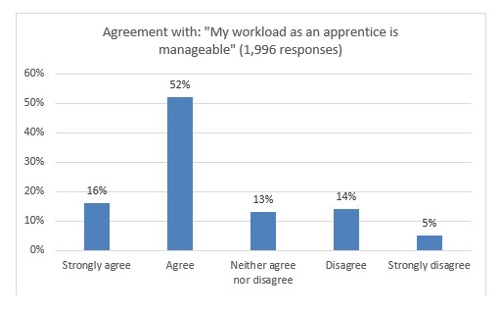
Most apprentices agreed that both their training provider (70%) and employer (78%) take steps to support their wellbeing. Apprentices under 22 were more likely to feel that their employer supported their wellbeing (84%), while apprentices working at SMEs were more likely to feel that their training provider supported their wellbeing (78%). Apprentices doing apprenticeships at levels 6 and 7 were less likely to feel their training provider took steps to support their wellbeing (57%).
Most apprentices felt as valued as other staff members at their employer (78%), that they had access to the same wellbeing support as other staff (92%) and that they would know who to contact if they had a welfare or wellbeing issue relating to their apprenticeship (87%).
Induction
79% of apprentices said that they received an induction to their apprenticeship from their employer. Apprentices under 22 (91%) were more likely to say they had received an induction from their employer, as were apprentices aligned to IfATE’s engineering, construction and transport route group (88%). On the other hand, female apprentices (72%), apprentices at level 6 or 7 (71%) and apprentices aligned to the people services route group (73%) were less likely to say they had received an induction.
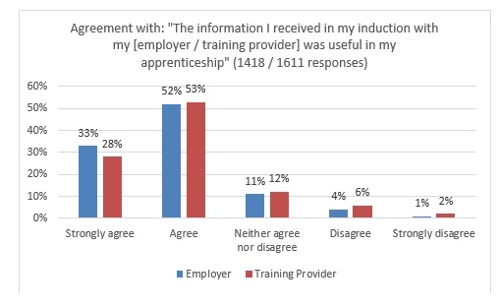
Apprentices were more likely to have received an induction from their training provider – 91% said they had. Level 6 and 7 apprentices (86%), and apprentices aligned to the engineering, construction and transport route group (85%) were less likely than apprentices overall to say they had received an induction from their training provider.
Most apprentices who had had an induction found it useful. 85% said their induction with their employer was useful, while 81% felt their induction with their training provider was useful. Apprentices working at SMEs were more likely than others to think that both types of induction were useful (90% for employer induction, 87% for training provider induction).
Only 30% of apprentices said that they had received information at their induction on how to connect with external apprenticeship networks.
Apprentice panel insights – apprenticeship networksWhen designing the survey, the panel felt it was important to understand how many apprentices received information that allowed them to connect with external apprentice networks for advice and support.Panel members were generally unsurprised by the result that relatively few apprentices (30%) recalled receiving this information as part of their induction.Discussing their own experiences in relation to the results, some panel members said that they were members of existing networks, and as with the survey respondents, many of these had found them independently, rather than being pointed to them by their employer or training provider. One panel member, feeling a lack of support from their organisation, had even set up their own network.Others said that their employer offered internal networks, and that these provided sufficient support for them during their apprenticeships, and they therefore would not have needed an external network. Some of these internal networks were specifically targeted at apprentices, while others were based around other issues (eg, staff disability networks).Another panel member highlighted the value of online networks, such as LinkedIn, and that line managers had encouraged them to access these.
Training
Most apprentices said they were learning skills, knowledge, and behaviours (KSBs) that were up to date (90%) and that would benefit them in their future careers (89%).
Apprentices under 22 were more likely than others to feel positive about this; 94% said their KSBs were up to date and 93% said it would benefit them in the future. Disabled apprentices were less likely than others to say they were learning up to date skills knowledge and behaviours (79%).
90% of apprentices felt they were learning transferable workplace skills that they could use in other roles.
Most apprentices (83%) felt they got opportunities in the workplace to practice and develop the skills they were learning in training. Again, apprentices under 22 were more likely to feel positive about this (89%), while disabled apprentices were less likely to say they had these kinds of opportunities (69%).
81% of apprentices said that they would ideally like at least half of their training to be face to face (rather than online). However, only 60% of apprentices reported receiving at least half of their training face to face.
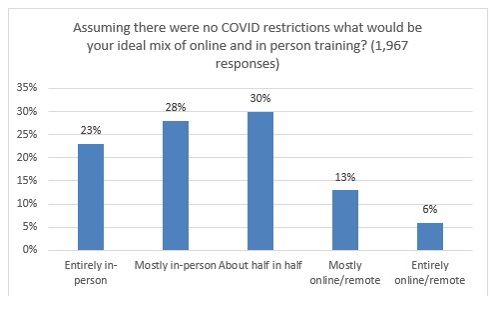
Overall, only 19% of apprentices said they wanted to learn either mostly or entirely online. However, some apprentices were more likely than others to want to learn online. Female apprentices (25%) and those aligned to the business services route group (38%) were more likely to want most or all of their training online. Apprentices under 22 (15%) and aligned to the engineering, construction and transport route group (4%) were less likely than average to want online training.
Apprentice panel insights – learning remotelyWhen discussing the results, panel members’ views were mixed on learning online. Some panel members said that focusing while learning online was difficult, while others saw learning at home as a helpful contrast from jobs where they were expected to be in the office, or as a way to learn at their own pace. One said they felt they were learning all the “in person” skills they needed while at work, so that it was more efficient to do their more formal learning online.Some panel members felt that the specific balance of online and in person study was less important, and that trying to specify a recommended balance for all apprentices was not appropriate. Instead, they argued that it was more important that individual apprentices were provided clarity when choosing a particular apprenticeship about what balance of online and in-person learning they could expect.
3- and 4-way partnership
Apprentices were less positive about how successfully their employers and training providers worked together. Only 53% agreed that their employer and training provider worked effectively together (down from 60% in 2020). Apprentices aligned to the engineering, construction and transport route group were less likely to feel their employer and training provider worked well together (46%), while apprentices at SMEs were more positive than others (64%).
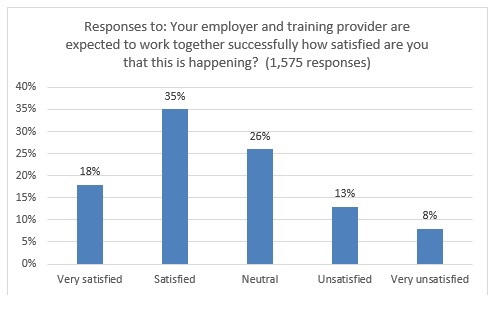
65% of apprentices reported satisfaction with the overall quality of service provided by their training provider, while 66% reported satisfaction when asked specifically about the responsiveness of their training provider.
Apprentices at level 6 and 7 (57%) were less likely to be satisfied with the overall quality of service received. Engineering, construction and transport apprentices were less positive both about the overall service (57%) and responsiveness (53%).
Apprentices at SMEs reported receiving a better overall level of service from training providers (79%) and better responsiveness (76%), while apprentices aligned to the care services route group were more satisfied just with responsiveness (77%).
Apprentice panel insights – employer / training provider relationshipPanel members wondered if the employer - training provider relationship varied by industry. A panel member whose apprenticeship was in the construction industry, for example, had had a good experience, and said that meetings between employer, apprentice and training provider were structured and regular.Other panel members said that they had needed to step in and proactively facilitate employer/training provider communications, as the other two parties had not seemed able or willing to do so. One panel member said they felt like they were “babysitting” the organisations in question, and that this had a negative impact on the time and energy they had had available for their work and training.An apprentice at an SME felt that the small size of their organisation allowed for a higher quality employer / training provider relationship, as it was clearer who was responsible, and easier for the training provider to get hold of the right person.
Apprentices were asked whether they had signed a commitment statement. Of those who responded Yes or No, 92% said they had and 8% said they had not. However, a large group also said that they were “not sure”. When the not sure responses are included, 64% of apprentices are certain they have signed a commitment statement, with 30% unsure and 5% sure they have not. Apprentices under 22 are less likely to have signed a commitment statement with 56% sure they have signed one. Level 6 or 7 apprentices are more likely to have signed a commitment statement – 78% reported signing one.
Of those who have signed commitment statements, a majority feel that the commitments within them are being met. 78% felt that the commitments were being met by their employer and 78% also felt that training providers were meeting their commitments. Apprentices under 22 were more likely to say their employers’ commitments were being met (85%), while apprentices aligned to the engineering, construction and transport route group were less likely to say their training providers’ commitment were being met (70%).
Apprentice panel insights – commitment statementsOne panel member said had found their commitment statement essential and had used the information on it to self-assess their own readiness for end-point assessment when their employer had not known that they were ready.However, several members could not remember signing commitment statements, and some were unaware what a commitment statement was. Others said they did not recall signing a specific statement but recalled having expectations explained to them verbally.Some panel members who did not recall signing a statement felt that their contract of employment would have covered the same information, and that a separate commitment statement would have been unnecessary.Panel members reflected on the name of the document – with some saying they would not have understood what it was for. Panel members wondered if a title using language like “agreement” or “expectations” would provide a clearer description.Panel members expressed concern that apprentices at higher levels were more likely to have signed commitment statements, as they felt that those at lower levels were likely to have less experience of training and the workplace, and therefore a greater need of the statement.
Standards
Apprentices were asked if they knew what their apprenticeship standard was. 80% of those who gave a substantive answer (ie “Yes” or “No”) said Yes, however this reduced to 62% when “not sure” responses were included in the analysis. Apprentices aligned with the business services route group were more likely to say they did know what their standard was, with 87% of those who gave a substantive answer saying that they did.
Of those who knew what their standard was, 77% knew where to find it, and 75% had read it (both figures quoted with “not sure” responses included). 86% said they could easily understand the language in the standard and 90% could understand how the content of the standard related to what they were doing day to day. 93% could understand how the standard related to the occupation they were working towards. 92% felt that the KSBs set out in their standard would equip them to succeed in the future.
Apprentices generally felt that their standards presented the right level of challenge, with 78% saying the level of challenge was appropriate, and only 16% and 7% saying it was too hard, or too easy, respectively.
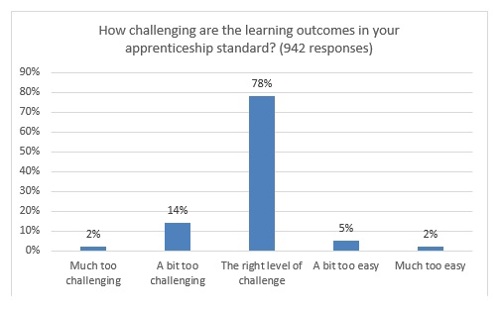
Of the 1,121 apprentices who said that their apprenticeship included a mandatory qualification, 82% thought it would be valuable for their future career.
Equity, diversity, and inclusion
Most apprentices felt that their employer (78%) and training provider (73%) would be willing to make adjustments to meet their needs. Apprentices under 22 were more likely than others to feel that their employer would be willing to make adjustments (83%), while those working for SMEs (82%), and those aligned with the care services route group (80%) were more likely to feel their training provider would make adjustments to meet their needs. Apprentices on the engineering, construction and transport route were less likely to feel that their training provider would make adjustments to meet their needs.
Apprentices mostly said they felt empowered to have successful careers in their industry (80%) and said that their apprenticeships specifically had made them feel more empowered (78%). Apprentices under 22 were more likely to report feeling empowered (85%).
Progression
68% of apprentices said that they knew how to find information about future training or qualifications to which they could progress. Apprentices at SMEs were more likely to say they knew how to find such information (78%).
About half of apprentices (52%) had considered future training or qualifications towards a different career path than the one they were currently on. Apprentices under 22 were more likely to say that they had considered this (60%).
End-point assessment
All apprentices were asked if they thought the skills they needed for their end-point assessment were a good match for the skills needed for their occupation. 73% agreed that they were a good match.
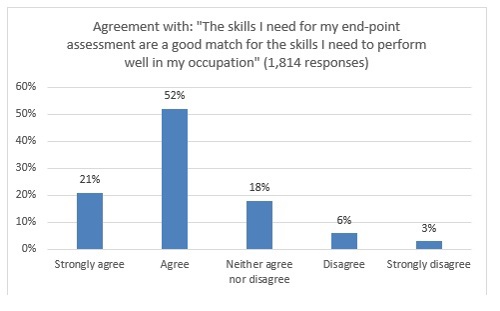
243 apprentices said they had passed through their apprenticeship gateway. These apprentices were asked about the support they had received towards their end-point assessment.
70% said that they were satisfied with the support they had received from their training provider, and 74% were satisfied with the support they received from their employer. 63% said they were satisfied with the support offered by their end-point assessment organisation.
Related links
Apprentice panel report on survey of apprentices – October 2022
Press notice: IfATE’s response to the survey of apprentices – October 2022
Apprentice panel report on survey of apprentices – August 2020
Raisings the standards: apprentice panel guidance on delivering high-quality apprenticeships
Supporting data
Survey data tables
Published 5 Oct 2022
Last updated 5 Oct 2022
(SH/NS)

